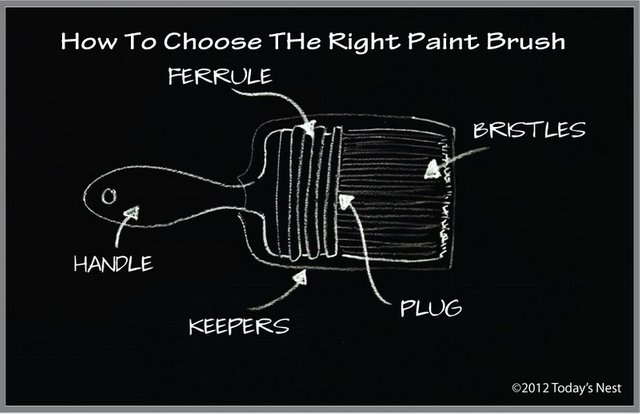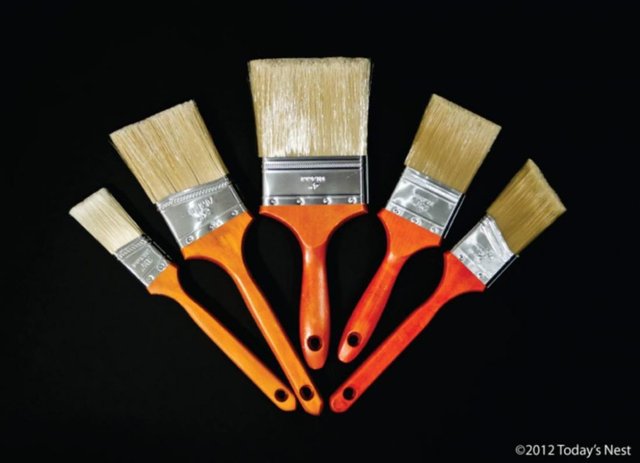How to Choose the Right Paint Brush
Does your paint brush really matter? You bet it does
You picked out the perfect paint or stain for your project. You’ve got drop cloths and masking tape at the ready. But now, what brush should you use? Every brush is not created equal. There are real differences that can impact the finish. Not only is the pairing of brush to paint/stain important, but the quality of brush you use will have an impact, as well.
We’ve outlined some of the highlights for you here to push your project in the right direction and help you keep from feeling painted into a corner.
Anatomy of a brush
Handle – most importantly, choose one that fits well in your hand. Made of wood or plastic. Common types are:
Beaver tail short handle – 2 inches long. It is good for maneuvering in tight, narrow places.
Beaver tail handle – usually 4 inches long. It is the standard size for most projects.
Sash handle – 6 ½ inches long. It is good for extra control when painting as it is easier to turn.
Ferrule – this is the metal piece that holds it all together. It can be made from copper, steel or tin.
Bristles – where all the magic happens. The butt end of the bristles are held together in an epoxy setting inside the ferrule. The tip end holds and delivers the paint.
Plug – this handy part is nestled within the bristles to divide them and act as a reservoir for the liquid. It is typically made of wood or cardboard. Better brushes will have smaller, thinner ones.
Keepers – this plastic sleeve is more than just packaging. Hold on to it to store your brush after each use. It is perfectly sized and fits over the handle, too.
In the Bristles
Flagged (or split) ends on bristles allow them to better hold and spread paint. The result is more even painting with fewer brush strokes on the painted surface. A good quality brush will have a high percentage of flagged bristles.
Except those intended for precision painting, higher quality brushes will also have bristles of varying length.
Bristles of good quality brushes are tapered. Tapering allows the bristles to hold more paint.
Some common types are:
Natural hog bristles – best for oil-based paints. Don’t bother to use these bristles with anything other than oil-based paints. The naturalness of them makes them prone to holding water which ends badly.
Nylon bristles – used for latex paints.
Polyester – can be used for all paints with relative success.
Types of brushes
Wall brush – use this one on walls, floors, and ceilings. Generally found in 3 to 5 inch versions, pick the one that suits you best. Remember that a 5 inch one loaded with paint all day could get very tiresome. Choose wisely.
Angle sash brush – use this one for more precise painting such as trim, sashes, and sills. It is perfect for cutting in corners. These most commonly come between 1 to 3 ½ inch varieties. 2 ½ inch seems to be favored by many painters.
Flat sash brush – use this one for wide trim and sashes. You will find this in a few sizes, but 3 inch is a good starting place.
More to consider
- You don’t necessarily have to buy the most expensive brush, but choose a good quality one that will last for many paint projects to come.
- Avoid those brushes with bristles secured by glue. Look for epoxy settings.
- Dipping your brush just halfway up the bristles is sufficient to load it with paint. If you dip it all the way to the ferrule you can cause damage, and at the very least, a clean-up nightmare.
- To release excess paint, gently tap both flat sides of the brush on the inside of the paint can. Break the habit of dragging the side along the inside of the can. This removes much of the paint that you just loaded.
Maintenance and care
- Clean brushes immediately to avoid hardening.
- Use a metal comb on wet bristles.
- Clean oil based paints from brushes with solvent. Use water and mild detergent to clean latex based paints.
- Keep brushes in the plastic sleeve (keepers) in which they were purchased. If you don’t have that any longer wrap brushes (with bristles flat) in aluminum foil.
- Always store flat or suspended by the hole in the handle to keep bristles straight.
- Soaking brushes in water can cause irreparable damage to the filament and/or epoxy setting and could cause the ferrule to rust.
- Need to take a break? Keep a supply of plastic wrap around to cover your brushes and keep them from drying out.
About the author:
Sam Henderson
In addition to being the co-owner of Savour Partnership, Sam Henderson is the owner and Creative Director of Savour Imagery, a food and lifestyle creative studio located in Dallas, Texas.
This article is originally published in Artisans List - a business directory website.

